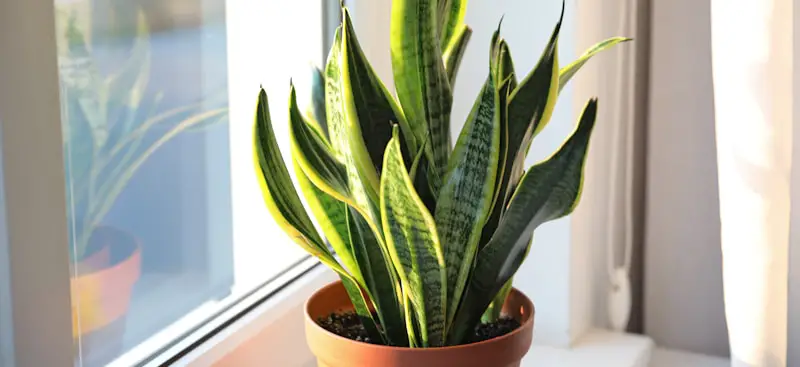All living things require water for survival, including plants – household and wild plants alike need to be watered. However, before watering your plant, you need to understand the rate and level of water necessary to keep it healthy. Overwatering or underwatering of a snake plant could result in certain undesired results, including the death of your plant.
If you own a snake plant, you should water it fortnightly – every two weeks; this is to prevent root rot and overwatering. The soil must be completely dried between the periods of watering. If you forget to water the plant, it will not die; snake plants can go without water for two weeks or more.
While it is important to know the frequency of watering a snake plant, it is also imperative to know how to water the plant to avoid watering mistakes. Factors like the position of the plant in the home also affect the watering.

How Often Should You Water A Snake Plant Indoors?
The snake plant, also known as Sansevieria, is a very common household plant. These plants are succulent and drought tolerant to varying environmental conditions, considering they are native to tropical West Africa. Snake plants are easy to maintain and do not require too much watering.
The rate at which you are expected to water a snake plant depends on certain factors. These factors greatly affect whether your plant needs to be watered once a week or every two weeks. However, before we explain these factors, the general rule is that snake plants should only be watered when the plant’s soil becomes dry.
You can easily detect the wetness or dryness of your snake plant soil by dipping a finger into the soil about a few inches below. Once your finger feels wet, you do not need to wet the soil. If you wet the soil, your snake plant is at risk of being overwatered, and there is a high chance of yellow leaves and drooping.
Conversely, if the soil is too dry and you notice the leaves appearing curly, wrinkly, or getting brown, it is a sign that your plant lacks water. In such cases, it indicates that your plant lacks adequate water, so you must provide it with water. You do not have to wait until the soil becomes too dry before watering your snake plant.
Once the soil appears dry, ensure you water it before it gets overly dry. One essential thing to take note of is that snake plants do not grow well when the water has high chlorine content. Now, let us examine some factors determining the rate you should water your snake plant below.
Temperature
One of the most important factors to consider in a plant’s life is temperature. Temperature is an environmental factor that greatly determines the rate at which a snake plant is expected to be watered. The ideal temperature for survival of a snake plant is between 55 0 Fahrenheit and 85 0 Fahrenheit.
Snake plants are expected to be watered more during hot temperatures, as their soil tends to dry out faster due to increased evaporation. However, during seasons when the weather gets a bit cool, the rate your soil dries out would reduce, so you need not water your plant until you notice the soil is dry. Very cold weather temperatures below 50 0 Fahrenheit are not good for these plants.
Plant Size
As your plant continues to grow, the rate of water it needs will also increase. This idea is simply due to transpiration, which occurs more in larger leaves than in smaller ones. So, ensure you make the necessary adjustment to the rate you water your snake plant soil as the plant grows bigger.
Soil Mix Type
Various soil mix types are available for indoor plants and have different water retention levels. Although many indoor plants are best planted in soil capable of holding water, snake plants do not thrive well in such soils. The best soil mix type for snake plants is the one that can retain more nutrients and drain moisture faster. A good example is the standard cactus mix.
Pot Material
Another factor that determines the rate you water a snake plant is the type of material in which your soil pot is made of. Pots made of plastics often hold water more as it does not usually give room for water evaporation from their sides. However, terracotta pots often give room for water loss as the potting material can absorb water.
So, if your snake plant is in a terracotta pot, you would need to water your plant more than those using plastic or glazed pots capable of holding water more. It is best to use a highly porous pot to plant your snake plants because they are the best option for indoor plants.
Plants Location
Certain indoor locations could expose your snake plant to light or heat, increasing the rate at which the soil dries out and affecting the rate you water your plant. So, you must ensure your plant is never placed in places close to heating appliances or very close to a window where sunlight could affect it.
Snake plants can withstand almost all lighting conditions; nevertheless, the ideal location for placing snake plants indoors is in the west or east-facing window position, where they can get bright indirect sunlight. This would prevent the plant soil from evaporating quickly and also save the plant leaves from suffering from sunburn.
How Often Should You Water A Snake Plant In Winter?
During winter, snake plants require little attention and care because they can survive for about a month without water. It would be best if you watered your snake plants once a month or every two weeks during the winter. While it may sound strange, you might overwater the snake plant in winter without proper understanding.
Snake plants store water in their leaves, and when overwatered, the leaves absorb and store more water than is needed, and this can damage the plant cells. When this happens, you notice the snake plant leaves splitting. If neglected for a long time, the plant dies eventually, and nobody wants that to happen.
During winter, you should not water your snake plants except if the soil is dry, there is no rigid routine for watering. Before you water the snake plants, use a moisture meter or a skewer to check if there is water in the soil. If the top two inches of the plant soil is dry, you should water it.

How To Water A Snake Plant Properly?
There are tons of mistakes you will make that can shorten the lifespan of your snake plants; it has been proven that most household plants die due to watering mistakes. One of the mistakes many people make when watering snake plants is watering the leaves. You should water only the base of the plant.
When watering a snake plant, you should water it until the water runs out from the bottom of the container. However, if you have a well-draining and well-aerated potting mix, you do not have to worry about too much water even when fully saturated. If there is an overflow dish under the pot, you should always empty it after watering.
Final Thoughts
Although the snake plant is an extremely drought-tolerant houseplant, you should not make the mistake of underwatering or overwatering it. It would help if you also considered the factors determining how often you water the snake plants, including lighting, humidity, temperature, soil type, pot size, plant size, and plant location.
Victoria is the owner and main author of hobby plants. She loves spending her free time in her garden planting and taking care of her plants. Victoria hopes you enjoy the content here!
![Why Is My Aloe Plant Turning Brown? [FIND OUT HERE] Why Is My Aloe Plant Turning Brown? [FIND OUT HERE]](https://www.hobbyplants.com/wp-content/uploads/2022/07/why-is-my-aloe-plant-turning-brown-300x158.jpg)
![Why Is My Bamboo Plant Turning Yellow? [Find Out Here] Why Is My Bamboo Plant Turning Yellow? [Find Out Here]](https://www.hobbyplants.com/wp-content/uploads/2022/07/why-is-my-bamboo-turning-yellow-300x158.jpg)
![Why Are My Bird of Paradise Leaves Curling? [FIND OUT HERE] Why Are My Bird of Paradise Leaves Curling? [FIND OUT HERE]](https://www.hobbyplants.com/wp-content/uploads/2022/07/bird-of-paradise-leaves-curling-300x158.jpg)
![Why Are My Orchid Leaves Turning Yellow? [Find Out Here] Why Are My Orchid Leaves Turning Yellow? [Find Out Here]](https://www.hobbyplants.com/wp-content/uploads/2022/07/orchid-leaves-turning-yellow-300x158.jpg)
![How To Propagate Bird Of Paradise? [Find Out Here] How To Propagate Bird Of Paradise? [Find Out Here]](https://www.hobbyplants.com/wp-content/uploads/2022/08/how-to-propagate-bird-of-paradise-300x158.jpg)
![How Big Do Different Types Of Azaleas Get? [Find Out Here] How Big Do Different Types Of Azaleas Get? [Find Out Here]](https://www.hobbyplants.com/wp-content/uploads/2022/09/how-big-do-azaleas-get-300x158.jpg)
![How Often Should You Water Pothos? [Complete Care Guide] How Often Should You Water Pothos? [Complete Care Guide]](https://www.hobbyplants.com/wp-content/uploads/2022/07/how-often-to-water-pothos-300x158.jpg)
![How Often Should You Water Ferns? [COMPLETE CARE GUIDE] How Often Should You Water Ferns? [COMPLETE CARE GUIDE]](https://www.hobbyplants.com/wp-content/uploads/2022/08/how-often-to-water-ferns-300x158.jpg)
![Polka Dot Plant Care? [Everything You Need To Know] Polka Dot Plant Care? [Everything You Need To Know]](https://www.hobbyplants.com/wp-content/uploads/2022/08/polka-dot-plant-care-300x158.jpg)
![How Do You Propagate a Money Tree? [COMPLETE GUIDE] How Do You Propagate a Money Tree? [COMPLETE GUIDE]](https://www.hobbyplants.com/wp-content/uploads/2022/06/how-to-propagate-money-tree-300x158.jpg)

